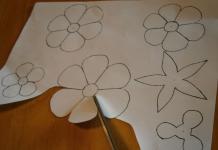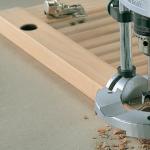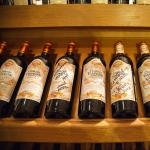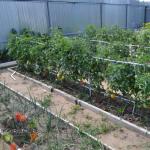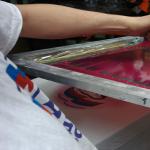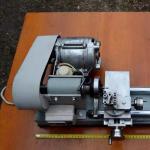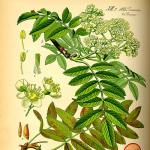Fruit trees bring large yields of fruit, so many gardeners want to propagate them on their site. Vaccinations do not always take root on the rootstock, so novice gardeners can use other methods of reproduction.
There are three main ways to propagate fruit trees, other than grafting:
- propagation by cuttings;
- layering;
- method of artificial formation of roots on a branch.
These propagation methods provide a high survival rate of new seedlings. At the same time, the new planting material completely retains all the properties of the mother tree, which is very important for the reproduction of a certain variety of fruit trees.
Propagation of fruit trees by cuttings
Cuttings for harvesting in the fall during the formation of the crown. You can store the cuttings deep frozen in the freezer or plant them in pots. Thus, you will form healthy seedlings, which you will then plant in open ground in the summer.
To obtain new seedlings, the green cuttings method is also used.
Cuttings should be planted in partial shade and well watered. Near the cuttings, several pegs are driven in, on which a white fabric is pulled. Thus, a miniature greenhouse is created. When the cuttings have a root system, they are transplanted to a sunny place and complex mineral fertilizers and rotted cow dung are introduced into the near-stem circle of the seedling.
With such reproduction, the survival rate of cuttings is 70% of the total amount of planting material.
Reproduction of fruit trees by layering
In order to get new plants with a guarantee, use the method of propagating fruit trees by layering. Select the lower branch of an adult fruit tree and remove the bark from it in a circle. This process is called banding.
Ringing slows down the flow of nutrients from the cutting, which increases the rate of formation of the root system. In order to start the process of root formation, bend the branch to the ground and fill the "ring" with earth.
After three months, the formation of the root system will begin, and next summer it will be possible to separate the seedling from the mother plant and transplant it to a new place. The survival rate of seedlings with this method of reproduction is 100%.
Artificial formation of roots on a branch
If it is not possible to bend the branch to the ground, make a hole in the plastic bag and put the bag on a straight branch, and then fill the bag with soil. Tie the bag loosely, providing air access to the branch, slightly moisten the soil. After the roots are formed, separate the seedling with secateurs and transplant to a new place.
HE. Aladina, doctor of agricultural sciences Sciences,
senior researcher fruit growing laboratory, prof. department of fruit growing
Green cuttings are one of the most promising methods of vegetative propagation, which makes it possible to obtain own-rooted plants on an industrial scale. The main stages of the technology were developed by the beginning of the 80s. A great contribution to its development was made by such scientists as M.T. Tarasenko, Z.A. Prokhorova, V.V. Faustov, B.S. Ermakov, F.Ya. Polikarpova, E.G. Samoshchenkov, V.K.Bakun, V.A.Maslova, A.G. Matushkin, I.M. Posnova, L.P., Skaliy and others.
Green cuttings are based on the natural ability of plants to regenerate - the restoration of lost organs or parts, the formation of whole plants from leafy stem cuttings after the formation of adventitious roots. Regeneration manifests itself differently and depends on many factors: life form, hereditary characteristics, age, condition of mother plants, rooting conditions, etc.
Green cuttings make it possible to increase the yield of cuttings from one mother plant (up to 200-300 pieces) and significantly (by 4-5 times) reduce the area of mother plants. It allows you to expand the number of species and varieties that can reproduce vegetatively and is indispensable for the rapid reproduction of forms that are available in the mother liquor in limited quantities (valuable breeding forms, rare varieties, healthy plants). Green cuttings contribute to the improvement of planting material: growing shoots are less populated by pests (glass, gall midge, bud mites) than lignified ones. A significant advantage of green cuttings is that the planting material is own-rooted plants, which are distinguished by physiological integrity and genetic uniformity; it provides not only a high multiplication rate, but also a shorter growing period. This technology is successfully combined with other methods: microclonal propagation, propagation by green grafting, lignified cuttings. It is possible to combine with the picking of strawberry rosettes, with the production of seedlings of flower, vegetable and medicinal plants.
The technology of green cuttings uses modern means of mechanization and automation of technological processes. Rooting of green cuttings and, in part, their growing are carried out in protected ground under controlled conditions, while the results of growing planting material do not depend on adverse climatic factors. Due to the intensive use of protected soil (dense placement of cuttings per unit area, the use of containers, the development of the vertical profile of greenhouses, the introduction of crop rotations), green cuttings are highly profitable.
The bottleneck of the existing technology is the large loss of rooted plants during storage and after transplanting for growing. Hard-to-propagate crops have a long period of root formation, rooting is not more than 30-50%, and poor development of the root system is the cause of poor survival during transplantation, low winter hardiness of rooted cuttings and low quality of planting material. The method is effective, but it requires significant additional costs for the laying of intensive mother liquors, the construction of a fogging plant with an automated system for regulating external conditions, the construction of cultivation facilities, rooms for grafting and winter storage of rooted cuttings, etc. Green grafting, despite the seeming simplicity of implementation, requires a good knowledge of the biological characteristics of propagated species and varieties, a well-thought-out system of measures for organizing production and clarity in the implementation of all technological methods.
Over several decades of research, the basic elements of the technology have been developed. It was found that the effectiveness of green cuttings depends on the life form of plants (woody ones take root poorly, lianas and herbaceous perennials are best) and species and varietal characteristics. It turns out that even within the same species (for example, varieties of apple, stone fruits, gooseberries, barberries), the rooting of cuttings is not the same.
It turned out that in order for the production of planting material to be profitable, the selection of breeds and varieties must be carried out taking into account their production value, consumer demand and the natural ability to reproduce by green cuttings. Rooting should be at least 60-90%, and the yield of standard seedlings should not be less than 30-40% of the original number of cuttings. The range of garden plants is varied and regularly updated. In this regard, it is necessary to provide for the prompt replacement of mother plantations.
In general, the role of mother plants can hardly be overestimated. It was found that the ability to reproduce by green cuttings is determined not only by hereditary characteristics, but also by the age and physiological state of the mother plants.
As a rule, plants in the early stages of their ontogeny exhibit a high regenerative capacity, which subsequently decreases with aging. In this regard, it is advisable to use queen cells up to 10-12 years of age, and even less in some breeds.
The costs of planting queen cells with pure-grade healthy planting material are completely justified, which significantly increases the cutting productivity of plantations and reduces protective measures and pesticide loads.
Many researchers rightly believe that when developing technologies for reproduction by green cuttings and in sterile culture, the condition of the mother plant is of paramount importance and consider it necessary to single out a preliminary stage, the purpose of which should be the targeted preparation of plants for reproduction.
Mother plants are planted densely in rows (like a hedge) with sparse row spacing. Within two years, plantings are pruned rather short to get branched plants that are uniform in strength. With restrained growth, shoots develop properties that promote the formation of root primordia. The compacted placement of bushes and strong pruning provide an increase in the total growth and, consequently, the yield of green cuttings per unit area of the mother liquor.
A highly effective technique is the cultivation of mother plants in protected ground: the yield of cuttings is 5-20 times higher than in open ground (increasing vegetative productivity is especially important at the initial stages of reproduction), the favorable period for cuttings increases up to three weeks, in a number of difficult-to-propagate plants, the rooting of cuttings increases by 20-35%.
Good hydration of the shoot tissues contributes to the successful rooting of the cuttings, so the soil moisture in the queen cells should not be lower than 70-80% of the field moisture capacity. In this regard, especially in protected ground conditions, continuous mulching of the soil with black polyethylene film is justified. Moisture is better preserved under the film, the soil warms up earlier in the spring, manual weeding is excluded. Favorable temperature and water regime in the root layer ensures powerful root growth, promotes better growth of the above-ground part and increases cutting productivity by 20%.
Of great importance is the provision of mother plants with mineral nutrients, but it should be borne in mind that an excess of nitrogen and excessive growth of shoots prevent the rooting of cuttings. Therefore, nitrogen fertilizers are applied only in the form of dressings in early summer.
Known methods include etiolation of mother plants: in early spring, annual and biennial branches are fixed horizontally and covered with an opaque film for 3-4 weeks. After removing the film, young etiolated shoots are spudded, leaving the tops. When the shoots reach a length of 20-25 cm, they are cut off at the base and grafted. In our country, this method is widely used in the cultivation of clonal rootstocks. Etiolation activates the excitability of the kidneys, incl. dormant, enhances shoot formation, increases the yield of cuttings from the mother plant, positively influencing the formation of root primordia. The reason is that etiolated shoots are younger in tissue development and surpass green shoots in terms of plastic substances, enzyme and hormone activity, especially IAA (β-indoleacetic acid), which induces adventitious root formation.
An effective method of preliminary preparation of shoots for cuttings is their local etiolation, which consists in isolating from light those parts of the stem that are basal when cutting cuttings. As the shoot grows, starting from a length of 5-7 cm, a spiral tube 30 mm long made of black polyethylene film is put on the upper part of the intensively growing shoot. As it grows, several more tubes are placed on the shoot according to the number of cuttings. With local etiolation, the rooting period is reduced by 2-3 times, the quality of the root system improves. Local etiolation allows for a long time to maintain the ability of the middle and lower parts of the shoot to root. The use of the entire shoot for cuttings ensures a high yield of planting material. In easily rooted species and varieties, root primordia are formed in shaded areas, which reduces the rooting time by 2 times.
Very promising is the complete shading of mother plants after heavy pruning in combination with local etiolation of the base of the shoots. Of particular interest is etiolation in combination with the cultivation of mother plants in protected ground, which makes it possible to significantly increase the multiplication factor and increase the number of rooted cuttings with growth by 1.5-2 times. When grown in a greenhouse and local etiolation, a similar reaction occurs, which is expressed in the restructuring of the anatomy of the stem of cutting shoots and increased meristematic activity.
A new direction in the preparation of initial plants for cuttings is associated with the use of growth regulators on mother liquors. The treatment of plants with biologically active substances affects the physiological state of plants, causing a chain of reactions that are not observed under usual conditions. The action of growth regulators is based on profound changes in the functional state of membranes, hormonal status, and many metabolic reactions.
Our twenty years of experience have proven the expediency of treating mother plants of fruit, berry and ornamental plants with growth regulators before cutting. The most effective use of retardants (chlorocholine chloride, kultar, pix, kim-112) and drugs with cytokinin activity (dropp, 6-BAP). After the treatment of mother liquors with growth regulators, root formation is enhanced in stem cuttings of medium- and difficult-to-root species and varieties, the yield of rooted material with a well-developed root system increases, winter hardiness and the proportion of standard seedlings increase. The combined use of growth regulators with urea nitrogen (5 g/l) and a complex of microelements (cytovit, 1 ml/l) has an undoubted advantage. A positive effect is achieved without treating the cuttings themselves with root formation stimulants, which greatly simplifies the cutting process, especially when propagating prickly plants (gooseberries, barberries, wild roses). After the application of retardants, cuttings of easily rooted plants take root well in simple greenhouses; cuttings of hard-to-root species and cuttings from open ground are best rooted under controlled conditions. In easily propagated plants, especially at a young age, a positive aftereffect is observed the next year.
It should be noted that the effectiveness of this method of preparation of mother plants depends on a number of factors.
A high effect is achieved when mother liquors are treated only in a certain phase of growth of annual shoots: for easily rooted plants - at the beginning, for hard-to-root - at the end of the phase of decaying growth. In the latter, the optimal phase is short and occurs earlier than in easily rooted crops. In protected ground, the favorable period for processing increases by 2-3 weeks.
In the manifestation of the maximum effect, the processing time during the day is also of great importance. Spraying of plants must be carried out in the morning (from 7 to 11) and evening (from 17 to 19) hours, when turgor is restored. There is an obvious connection with the state of stomata, which, in turn, depends on temperature, illumination, provision of plants with moisture, and the intensity of assimilation processes.
The best results were obtained by us in years with humid and very warm weather. Experiments have confirmed that in dry years the quality of tillage increases against the background of irrigation (60-70% of PV). At the same time, hard-to-root forms are especially responsive.
When mother plants are grown in protected ground with continuous mulching and regular watering, the effectiveness of treatments increases and to a lesser extent depends on the weather during the growing season. In addition, when keeping queen cells in a greenhouse, the period from processing to the start of grafting is reduced to 3-6 days; in open ground, it is longer and is 2-3 weeks.
Annual pruning of mother plants is necessary, but it should be borne in mind that with a very strong shortening, the total growth is significantly reduced. In addition, it is important to maintain several branching orders in order to limit the number of strongly growing axial, fattening shoots, the cuttings from which take root poorly.
In the technology of green cuttings, the size and type of cuttings are indeed of great importance. For harvesting cuttings, it is best to use a one-year increase in higher orders of branching, medium growth strength, from a well-lit side of the crown. The size of the cuttings depends on the planned release of planting material, the characteristics of the culture. It is known that plants from long cuttings develop better, however, in common practice, the average length of the cutting is 12-15 cm. When propagating species with large leaves, 2-3-node cuttings are used. As a rule, combined (with part of last year's wood) and apical cuttings take root better, however, much depends on the timing of cuttings.
In some breeds, the optimal cutting time is relatively short (10-14 days) and clearly coincides either with the phase of intensive shoot growth (cherry, plum, peach, lilac, barberry, golden and red currant, etc.), or with the phase of fading growth (European gooseberry varieties, sea buckthorn, clonal rootstocks, apple tree, quince). As a rule, these are breeds with a reduced ability to reproduce. In easily rooted plants, the period of green cuttings is more extended and can continue in central Russia from early June to mid-August. Coniferous plants (thuja, juniper, cypress, biota) with a long period of rooting are best cut in mid-late June. With the content of queen cells in protected ground, the period of grafting of individual breeds is more extended. When determining the timing of cuttings, one should pay attention to such indicators as the flexibility or brittleness of the shoot, the degree of lignification, and the presence of a grassy top. When harvesting shoots and cuttings, wilting should not be allowed. It is better to harvest them in the morning, when the tissues of the plants are saturated with moisture.
Treatment of the basal parts with growth regulators was the most effective technique stimulating the regeneration of adventitious roots in green cuttings. This technique provides a great economic effect at low labor and cost. At one time, thanks to the discovery of the ability of certain hormonal preparations to stimulate root formation, many crops that were difficult to propagate were transferred to the rank of medium and easy rooting.
As rooting stimulants, β-indolyl-3-acetic acid (IAA) or heteroauxin (50–200 mg/l) is most often used; β-indolyl-3-butyric acid (IMA; 5-100 mg/l); α-naphthylacetic acid (NAA, 5-50 mg/l). Under production conditions, 4 methods of processing with growth regulators are used:
- weakly concentrated aqueous solutions (the lower ends of the cuttings are immersed in the solution for a sufficiently long time (16-24 hours);
- concentrated alcohol solutions; the depth of immersion in the solution of the lower ends of the cuttings is minimal, the treatment exposure is from one to several seconds;
- growth paste; the paste can be applied in advance on the shoots on mother plants or on the lower part of the harvested cuttings
- growth powder; the cuttings are lowered with the bases into the powder-powder (root), and then planted for rooting.
Treatment of cuttings with aqueous solutions is the simplest, most accessible and widely used method in green cuttings technology. The optimum temperature of the working solution is +18...+20°C. The concentration of the drug and the duration of treatment depend on the root-forming ability and the degree of lignification of the shoots.
Despite the high stimulating activity of synthetic auxins, their use is currently limited, since they are toxic compounds. A search is underway for equally effective, but environmentally friendly drugs. It turned out that vitamins (ascorbic acid, thiamine) and the drug zircon, acting as antioxidants, IAA, as well as phenolic compounds (rutin, succinic, gallic, salicylic, ferullic acids) and steroid glycosides (emistim, ecost) showed stimulating properties.
Our studies have made it possible to identify as effective root formation stimulants preparations obtained on the basis of endophytic fungi (nikfan, symbiont, mycephyte), epin, potassium lignohumate, cresoacetic acid salts (cresacin, cresival, etirane), chitosan derivatives (ecogel), Baikal EM-1 preparation.
Researchers and practitioners are unanimous that the rooting conditions (humidity, temperature, light, substrates) are perhaps the most important factor in the successful rooting of green cuttings. For active root formation, a complex of factors is required that can simultaneously ensure the maximum reduction in transpiration, intensive photosynthesis, and hormonal activity of the leaves. The classical literature on green cuttings provides exhaustive material on the reaction of cuttings of different breeds and varieties to external conditions, on the design of greenhouses and fogging installations, optimization of modes, arrangement of ridges, preparation of substrates, methods of hardening, etc.
However, despite the fact that the main elements of the technology at the rooting stage are quite well developed, one cannot ignore some new techniques that allow increasing the yield of high-quality and viable rooted material per unit area of greenhouses, increasing its persistence after transplantation and during winter storage.
Good rooting results were obtained by us on a substrate containing the following components: high-moor peat, coarse-grained perlite and fresh dehydrated, stabilized urban sewage sludge (UGSV; Kuddek fertilizer) in equal parts by volume. Such a substrate has good physical properties, contains all the necessary nutrients, is free from pathogenic flora, and has significant hormonal activity, incl. auxin. The latter property allows the rooting of easily propagated shrubs without the use of growth regulators. It can also be added that, when growing rooted cuttings in containers, the inclusion of GHSV in the substrate promotes rapid initial growth, powerful development of the root system and the aerial parts of plants.
An unconventional but very effective approach to the problem of rooting is the use of foliar treatments of green cuttings with growth regulators. The positive effect of foliar top dressing of cuttings with mineral fertilizers (urea, superphosphate, potassium chloride or potassium salt, complex fertilizers) is known, which ensures good development of the root system under leaching conditions.
We found that single foliar treatments of green cuttings at the beginning of root formation with physiologically active substances and their mixtures have a significant positive effect on both root formation and the resistance of rooted plants to adverse external factors and the yield of high-quality planting material. The phase of the beginning of root formation varies depending on the root formation ability of plants: in easily rooted plants, it occurs in 2-4 weeks, in hard-rooted plants - in 4-6 weeks after planting. According to the results of many years of experience, stable results are obtained by foliar treatments with drugs with cytokinin activity (dropp, 6-BAP, cytadef (20-50 mg/l); potassium lignohumate (150-200 mg/l), epin (0.2 ml/l); mycefit (10 mg/l), cherkaz (40-50 mg/l). uric acid (cresacin, crezival, etirane (10-40 mg/l). The effect is enhanced by the combined use of substances and compounds with urea nitrogen (5 g/l) and microelements (cytovit, 1 ml/l).
The problem of winter hardiness of rooted plants, especially such as gooseberry, honeysuckle, cinquefoil, barberry, cherry, etc., which do not winter well and are stored, can be solved by rooting cuttings in plastic cells with a diameter of 5 cm. As a rule, cuttings root in cassettes worse than in ridges, but the methods listed (use of combined cuttings and substrates with OGSS, foliar treatments) significantly increase the yield rooted material with an intact, rooted root ball. Such cuttings are well stored both in cassettes and in bulk in the basement at low positive temperatures, successfully winter in open ground after transplantation and are the best suited for container culture. When planting in February, by the beginning of June, a good quality planting material of berry and ornamental shrubs is obtained. And after rearing in the open field, almost all planting material can be attributed to the standard.
The report was made at the V annual conference of APPM, February 2012.
Possession of such techniques as grafting, rooting cuttings, etc., allows you not only to replenish your gardens with your favorite plants and carry out their timely “repair”, but also, if you wish, make good money by selling rooted seedlings on the market. Especially now, when a real boom has begun among the owners of private houses and cottages to decorate their territory with beautiful, rare (and not so) ornamental plants.
Green cuttings
Propagation of woody plants by green cuttings is becoming one of the main ones in ornamental gardening. The best age of mother plants from which green cuttings are cut is considered to be from 5 to 10 years; cuttings of hard-to-root plants are taken from younger (2-3 years) plants.
The best terms for green cuttings of varietal lilacs and mock oranges occur during flowering (but cuttings should not be cut from shoots that have flowers or flower buds), and for a number of other forms and types of hardwoods - during the period of intensive growth of shoots. Summer cuttings in a greenhouse with strong lateral shoots of the mother plant “with a heel” (a heel is a piece of last year’s wood) or apical cuttings are recommended for barberry, euonymus, weigela, wolf, hydrangea, honeysuckle, cinquefoil, viburnum, cotoneaster, broom, rhododendron, etc.
The conifers are cut either in the spring, before the buds begin to swell (for example, shoots of thuja western, spruce, fir and junipers are harvested from late April to early May), or in summer, when they finish active growth (from mid-June to mid-July).
Little secret:when propagating conifers, use shoots from the top of the plant. Cuttings taken from the lower shoots often grow into atypical plant species or form.
We collect cuttings
Cutting shoots into cuttings is best done either early in the morning or on a cloudy day; large leaf blades are shortened by half and cut shoots are placed with their lower ends in a vessel with water.
For successful root formation, the length and thickness of the cutting are important. The length of the cutting is determined by the size of the internodes: from shoots with short nodes, cuttings are cut with 3-4 internodes, from shoots with long nodes - with 2 internodes.
Holding the prepared shoot in the air, cuttings are cut from it with a sharp knife: the upper cut is made straight directly above the bud, and the lower cut is oblique, 0.5-1 cm below the base of the bud. Remove the lower leaves from the cuttings.
Before planting, cut cuttings are placed in a container with a small amount of water, sprayed and covered with a damp cloth. Freshly cut cuttings of conifers (spruce, pine) must be kept in water for 2-3 hours (since a resin is released on the cut surface that prevents the absorption of water from the substrate after planting), before planting, the cut is renewed and, to facilitate root formation, a longitudinal split is made to a depth of 1 cm.
Landing
For planting green cuttings, cold greenhouses or greenhouses are used; one or more cuttings can be planted in a pot. A layer of fertile loose earth mixed with sand (10-15 cm) is poured at the bottom, and a layer of coarse-grained clean sand (3-5 cm) is poured on top.
Before planting, to stimulate root formation, the base of the cutting is placed in a 0.01-0.02% solution of heteroauxin (even better, a 0.01-0.02% solution of succinic acid) for 12-14 hours.
The cuttings are planted vertically in the soil of the greenhouse, tightly compressing the soil around the cutting. The depth of planting depends on the size and breed of the cutting: they are usually planted at a depth of 1.5-2.5 cm. The distance between the cuttings in rows is 4-7 cm, between the rows is 5-10 cm.
The optimum temperature for rooting cuttings is 20-25 degrees.
During the rooting period, the cuttings (from 3 to 8 weeks, depending on the breed) are watered and sprayed with water 2-4 times a day (less often in cloudy weather, more often in sunny weather). Periodic spraying of cuttings with the addition of "Epin" accelerates the rooting process.
If the stalk is planted in a pot, then for its better rooting a mini-greenhouse is built in the pot.
What then
Soon after planting, a callus begins to form in the lower part of the cutting (an outgrowth is a neoplasm of cells on the wound surface of the plant), and then roots appear.
After the rooting of the cuttings, the buds begin to grow. When small shoots are formed, the greenhouses begin to open a little to harden young plants. With good shoot growth, the frames are opened more and more often and the cuttings are aired for longer and longer, and then the frames are removed completely. Usually at the end of August-September, successfully rooted cuttings are completely open.
Well-rooted cuttings of fast-growing hardwoods can be transplanted into open ground in autumn for their best development; slow-growing conifers are grown at the rooting site for 2-3 years.
Among the countless varieties and hybrids of sweet peppers, there are such as, for example, Ramiro peppers, whose popularity is literally global. And if most of the vegetables on the shelves of supermarkets are nameless, and it is almost impossible to find out about their varietal affiliation, then the name of this Ramiro pepper will certainly be on the package. And, as my experience has shown, this pepper is worth knowing about it and other gardeners. That is why this article was written.
Autumn is the busiest time. It is no longer hot, in the morning there is heavy dew. Since the earth is still warm, and foliage has already attacked from above, creating a very special microclimate in the surface layer, the mushrooms are very comfortable. Mushroom pickers are also comfortable at this time, especially in the mornings when it is cooler. It's time for both to meet. And, if not introduced to each other - get to know each other. In this article I will introduce you to exotic, little-known and not always edible mushrooms that look like corals.
If you are a busy person, but at the same time not without romance, if you have your own plot and you are endowed with aesthetic taste, then explore the opportunity to purchase this wonderful ornamental shrub - Caryopteris, or Nutwing. He is also a "wing hazel", "blue fog" and "blue beard". In it, indeed, unpretentiousness and beauty are fully combined. Cariopteris reaches its decorative peak at the end of summer and autumn. It is at this time that it blooms.
Pepper ajvar - vegetable caviar or thick vegetable sauce made from bell peppers with eggplant. Peppers for this recipe are baked, and for quite a long time, then they are also stewed. Onions, tomatoes, eggplants are added to ajvar. For harvesting for the winter, caviar is sterilized. This Balkan recipe is not for those who like to make preparations quickly, undercooked and underbaked - not about ajvar. In general, we approach the matter in detail. For the sauce, we choose the most ripe and meaty vegetables on the market.
Despite the simple names (“sticky” or “indoor maple”) and the status of a modern substitute for indoor hibiscus, abutilons are far from the simplest plants. They grow well, bloom profusely and delight with a healthy look of greenery only in optimal conditions. On thin leaves, any deviations from comfortable lighting or temperatures and violations in care quickly appear. To reveal the beauty of abutilons in rooms, it is worth finding the perfect place for them.
Pancakes from zucchini with parmesan and mushrooms - a delicious recipe with a photo of the available products. Ordinary squash pancakes can easily be turned into a boring dish by adding a few savory ingredients to the dough. In the zucchini season, treat your family to vegetable pancakes with wild mushrooms, it is not only very tasty, but also satisfying. Zucchini is a versatile vegetable, it is suitable for stuffing, for preparations, for second courses, and even for sweets there are delicious recipes - compotes and jams are made from zucchini.
The idea of growing vegetables on the grass, under the grass and in the grass is at first scary, until you feel the naturalness of the process: in nature, everything happens that way. With the obligatory participation of all soil living creatures: from bacteria and fungi to moles and toads. Each of them contributes. Traditional tillage with digging, loosening, fertilizing, fighting all those we consider pests destroys the biocenoses that have been created for centuries. In addition, it requires a lot of labor and resources.
What to do instead of a lawn? So that all this beauty does not turn yellow, does not hurt and at the same time looks like a lawn ... I hope that the smart and quick-witted reader is already smiling. After all, the answer suggests itself - if nothing is done, nothing will happen. Of course, there are several solutions that can be used, and with their help, reduce the area of the lawn, and therefore reduce the laboriousness of caring for it. I propose to consider alternative options and discuss their pros and cons.
Tomato sauce with onion and sweet pepper - thick, fragrant, with pieces of vegetables. The sauce cooks quickly and turns out thick because this recipe is with pectin. Make such preparations at the end of summer or autumn, when the vegetables have ripened under the sun in the beds. From bright, red tomatoes you get the same bright homemade ketchup. This sauce is a ready-made spaghetti dressing, and you can also just spread it on bread - very tasty. For better preservation, you can add a little vinegar.
This year I often saw a picture: among the luxurious green crown of trees and shrubs, here and there, like candles, the tops of the shoots are “burning”. This is chlorosis. Most of us know about chlorosis from school biology lessons. I remember that this is a lack of iron ... But chlorosis is an ambiguous concept. And not always lightening the foliage means a lack of iron. What is chlorosis, what our plants lack in chlorosis and how to help them, we will tell in the article.
Korean-style vegetables for the winter - a delicious Korean salad with tomatoes and cucumbers. The salad is sweet and sour, spicy and slightly spicy, because it is prepared with seasoning for Korean carrots. Be sure to prepare several jars for the winter, in the cold winter this healthy and fragrant snack will come in handy. For the recipe, you can use overripe cucumbers, it is better to harvest vegetables in late summer or early autumn, when they are ripe in the open field under the sun.
Autumn for me is dahlias. Mine begin to bloom already in June, and all summer the neighbors look over the fence to me, reminding me that I promised them a few tubers or seeds by autumn. In September, a tart note appears in the aroma of these flowers, hinting at the approaching cold. So, it's time to start preparing plants for a long cold winter. In this article I will share my secrets of autumn care for perennial dahlias and preparing them for winter storage.
To date, the efforts of breeders have bred, according to various sources, from seven to ten thousand (!) varieties of cultivated apple trees. But with their huge variety in private gardens, as a rule, only a couple of popular and beloved varieties grow. Apple trees are large trees with a spreading crown, and you cannot grow many of them in one area. But what if you try to grow columnar varieties of this crop? In this article I will talk about such varieties of apple trees.
Pinjur - Balkan eggplant caviar with sweet peppers, onions and tomatoes. A distinctive feature of the dish is that eggplants and peppers are first baked, then peeled and simmered for a long time in a brazier or in a saucepan with a thick bottom, adding the rest of the vegetables indicated in the recipe. The caviar is very thick, with a bright, rich taste. In my opinion, this cooking method is the best of all known. Although it is more troublesome, the result compensates for the labor costs.
Gardener 24
Planting an orchard is a responsible thing. The owner makes a plan for the future garden, thinks over what and where to plant. Then he goes to the nursery and buys seedlings.
Over time, especially if things are going well in the garden, a person who is passionate about growing fruit trees is tempted to grow fruit tree seedlings himself. Sometimes such a need arises from practical considerations: you need to expand the garden with your favorite varieties, or those varieties that you want to plant until you get it, but you can take grafting material from a neighbor and try to make it in order to grow a full-fledged tree.
So what ways to propagate fruit trees currently practiced? It has long been known that during the germination of seed material, not the tree that we need grows, but its ancestor, so to speak - a wild, in a word. Breeding science has come a long way in recent centuries. Breeders have long found out that when obtaining new varieties of fruit trees, it is not necessary to change the plant at the gene level, it is enough to make changes vegetatively.
Vegetatively modified plants cannot be propagated in a certain (through seeds) sense. To do this, each new plant must also be changed vegetatively, or use the method of vegetative division. For the propagation of fruit trees and berry bushes, three different methods are mainly used: cuttings, grafting, layering.
Reproduction by layering
The simplest method of vegetative propagation is propagation by layering. Performed in early spring. The disadvantage of this method is that not all trees, due to their structure, are suitable for such propagation. Shrubs are another matter, shrubs are undersized, and they are almost all suitable. For layering, a branch is chosen that is sufficiently developed, low-lying. The branch is cleaned from the bark in one of the buds closer to the beginning, so that it is convenient to sprinkle this place with earth.
The branch is fixed with a wire slingshot, sprinkled with earth, the remaining end of the branch is straightened, but not bent, and fixed in a vertical position with a peg. During the summer, roots form on the cleaned part of the branch, shoots develop from the buds above the buried place. In the autumn of the following year, the branch is cut off with a pruner, and the resulting young plant is transplanted to a new place.
Reproduction by grafting
Vaccination is used when there are ready-made - wild seedlings. They usually grow from seeds under the mother tree. Scion - a bud or cutting of a grafted plant takes root on a stock, resulting in a new fruit tree with known properties. Vaccinations are done in the spring, during the swelling of the kidneys. Material for vaccinations is harvested in late autumn, stored in a cool, dark place. Grafting with a bud is called budding, for this, a bud is removed from the mother plant, a place under the bud is cleaned on the rootstock, and, after applying the graft, it is treated with garden pitch and the graft is fixed with plastic tape.


The success of the grafting can be assessed when leaves begin to develop from the grafted bud, which means that the fusion of the tissues was successful. Then it remains only to form the crown of the plant with pruning. Grafting with a cutting is called copulation, for this the cutting is cut from the mother plant, an oblique cut is made on the rootstock, or an oblique lateral incision is made, or a crevice is made by cutting the stem of the stock vertically. An incision of the same shape is made on the cutting, and combined with the stock, so that the bark is in contact. The grafting site is treated with garden pitch and bandaged with plastic tape.
Reproduction by cuttings
By cuttings it is easy to propagate berry bushes - cherries, currants. The cuttings of these plants easily give roots. For cuttings, cuttings are cut in late autumn, and stored in a cool, dark place until spring. In the spring they dig into damp sandy soil. If a shoot has appeared, it means that rooting has occurred, you can transplant it to a permanent place in the fall.
